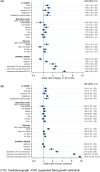Risk factors for a serious adverse outcome in neonates: a retrospective cohort study of vaginal births
- PMID: 37156754
- PMCID: PMC10952606
- DOI: 10.1111/1471-0528.17531
Risk factors for a serious adverse outcome in neonates: a retrospective cohort study of vaginal births
Abstract
Objective: To investigate the hypothesis that risk factors in addition to an abnormal fetal heart rate pattern (aFHRp) are independently associated with adverse neonatal outcomes of labour.
Design: Observational prospective cohort study.
Setting: 17 UK maternity units.
Sample: 585 291 pregnancies between 1988 and 2000 inclusive.
Methods: Adjusted odds ratios (OR) with 95% confidence intervals (95% CI) were estimated from multivariable logistic regression.
Main outcome measures: Adverse neonatal outcome at term (5-minute Apgar score <7, and a composite measure comprising 5-minute Apgar score <7, resuscitation by intubation and/or perinatal death).
Results: Analysis was based on 302 137 vaginal births at 37-42 weeks inclusive. We found a higher odds of Apgar score at 5 minutes <7 with suspected fetal growth restriction (OR 1.34, 95% CI 1.16-1.53), induction of labour (OR 1.41, 95% CI 1.25-1.58), nulliparity (OR 1.48, 95% CI 1.34-1.63), booking body mass index ≥30 (OR 1.18, 95% CI 1.02-1.37), maternal age <25 (OR 1.23, 95% CI 1.10-1.39), black ethnicity (OR 1.21, 95% CI 1.03-1.43), early-term birth at 37-38 weeks (OR 1.13, 95% CI 1.02-1.25), late-term birth at 41-42 weeks (OR 1.14, 95% CI 1.01-1.28), use of oxytocin (OR 1.27, 95% CI 1.14-1.41), maternal pyrexia (OR 1.87, 95% CI 1.46-2.40), aFHRp and presence of meconium (aFHRp without meconium: OR 2.40, 95% CI 2.15-2.69; meconium without aFHRp: OR 2.20, 195% CI.94-2.49; both aFHRp and meconium: OR 4.26, 95% CI 3.74-4.87). The results were similar when the composite adverse outcome was considered.
Conclusions: A range of risk factors, including suspicion of fetal growth restriction, maternal pyrexia and presence of meconium, are implicated in poor birth outcomes in addition to aFHRp. Interpretation of the fetal heart rate pattern alone is insufficient as a basis for decisions about escalation and intervention.
Keywords: fetal deterioration; intrapartum fetal monitoring; labour outcome; meconium; pyrexia; risk factors.
© 2023 The Authors. BJOG: An International Journal of Obstetrics and Gynaecology published by John Wiley & Sons Ltd.
Conflict of interest statement
PJS is the medical director and a shareholder in CaretekMedical, a company that has produced a smartphone app for women to assess their antenatal risk factors (
Figures


References
-
- Magro M. Five years of cerebral palsy claims. A thematic review of NHS Resolution data. 2017. https://resolution.nhs.uk/wp‐content/uploads/2017/09/Five‐years‐of‐cereb... Accessed 22 Aug 2022.
-
- NHS Resolution . NHS Resolution annual report and accounts 2020 to 2021. 2021. https://resolution.nhs.uk/wp‐content/uploads/2021/07/Annual‐report‐and‐a... Accessed 22 Aug 2022.
-
- Royal College of Obstetricians and Gynaecologists . Each Baby Counts. https://www.rcog.org.uk/about‐us/groups‐and‐societies/the‐rcog‐centre‐fo... Accessed 22 Aug 2022.
-
- Royal College of Obstetricians and Gynaecologists . Each Baby Counts. 2015 full report. 2017. https://www.rcog.org.uk/media/3fopwy41/each‐baby‐counts‐2015‐full‐report... Accessed 22 Aug 2022.
Publication types
MeSH terms
Grants and funding
LinkOut - more resources
Full Text Sources
Medical

